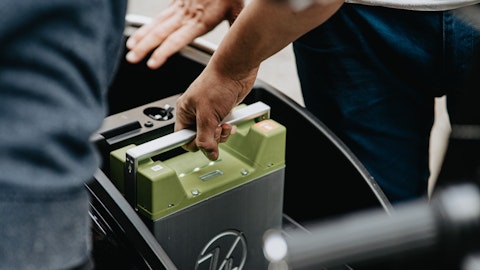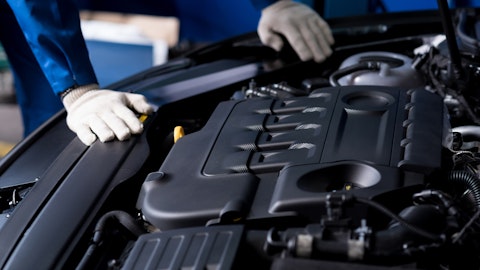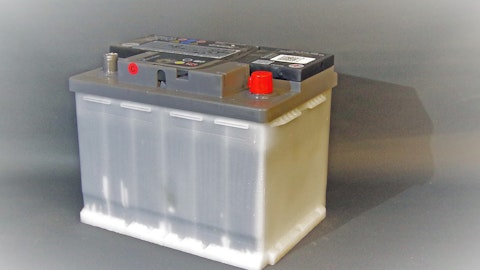Sensata Technologies Holding plc (NYSE:ST) Q3 2023 Earnings Call Transcript October 31, 2023
Operator: Good day and welcome to Sensata Technologies Q3 2023 Earnings Call. [Operator Instructions] Please note, this event is being recorded. I now will turn the conference over to Mr. Jacob Sayer, VP Finance. Please go ahead, Sir.
Jacob Sayer: Thank you, Rocco and good morning, everyone. I’d like to welcome you to Sensata’s third quarter 2023 earnings conference call. Joining me on today’s call are Jeff Cote, Sensata’s CEO and President; and Paul Vasington, Sensata’s Chief Financial Officer, and Brian Roberts, Sensata’s incoming Chief Financial Officer. In addition to the financial results press release we issued earlier today; we will be referencing a slide presentation during today’s conference call. The PDF of this presentation can be downloaded from Sensata’s Investor Relations website. This conference call is being recorded and we will post a replay webcast on our Investor Relations website shortly after the conclusion of today’s call. As we begin, I’d like to reference Sensata’s Safe Harbor statement on Slide two.

An industrial facility with a close-up of the asset tracking sensors, highlighting the company’s IoT solutions.
During this conference call, we will make forward-looking statements regarding future events or the financial performance of the Company that involve risks and uncertainties. The Company’s actual results may differ materially from the projections described in such statements. Factors that might cause such differences include but are not limited to, those discussed in our Forms 10-Q and 10-K as well as other subsequent filings with the SEC. We encourage you to review our GAAP financial statements in addition to today’s presentation. Most of the information that we will discuss during today’s call will relate to non-GAAP financial measures. Our GAAP and non-GAAP financials, including reconciliations are included in our earnings release and in the appendices of our presentation materials.
The Company provides details of its segment operating income on Slides nine and 10 of the presentation, which are the primary measures management uses to evaluate the performance of the business. Jeff will begin today with highlights of our business results during the third quarter. He will then provide a few updates on new launches and exciting applications that we’ve discussed on prior calls, and then provide an update on our progress in electrification. Paul will cover our detailed financials for the third quarter, updates on capital deployment, and he will discuss our financial guidance for the fourth quarter of 2023. We’ll then take your questions after our prepared remarks. Now, I’d like to turn the call over to Sensata’s CEO and President, Jeff Cote.
Jeffrey Cote: Thank you. Thank you very much, Jacob, and welcome, everyone. I’m very pleased to introduce Brian Roberts. As announced this morning, Brian will be joining Sensata and taking over the CFO responsibilities after the filing of our Form 10-Q next week. Brian is a seasoned financial executive with extensive public and private Company executive experience. Brian most recently served as CEO of Tarveda Therapeutics, rising to the President and CEO spot from the CFO role. Brian previously served as a public Company CFO at both Insulet and Digitas. He also brings significant public board experience, including eight years serving as Audit Committee Chair at ViewRay, Inc. The depth of his experience is described in the press release we issued this morning.
We welcome Brian to Sensata and look forward to working with him. I’d like to thank Paul for his nearly 10 years of service to Sensata and wish him well in his upcoming retirement. Paul has been instrumental in guiding Sensata through a significant strategic shift and navigating through the pandemic. We appreciate that Paul will be continuing as an adviser to me and Brian for the next several months to ensure a smooth transition of this very important role. Now, I’m going to move to some summary thoughts on our performance during the third quarter, as outlined on Slide three. During the third quarter, we produced $1.1 billion revenue, down 1.7% from the prior year period and in-line with our guidance range. Market growth for the last 12 months remained within our target range at approximately 460 basis points and 660 basis points over the past three years.
Strong recent business wins, new product development activities and the upcoming launch schedules gives us confidence that our revenue growth will accelerate in the coming years. Adjusted operating income was $192 million or 19.1%, down 30 basis points compared to prior year on a reported basis and up 90 basis points on a constant currency basis. Adjusted net income moved higher by 5.5% to $138 million, and adjusted earnings per share grew 7% on a reported basis and 16.5% on a constant currency basis to $0.91 from the prior year period. During the quarter, we took a $21 million charge for our recently announced restructuring program. This program is expected to generate $40 million to $50 million in savings in 2024. As we continue to focus our strategy on Electrification, harvest the investments of the past few years and actively manage our cost structure, we expect to see the benefit drop to the bottom-line.
At the beginning of 2023, we shared with investors a shift in our capital deployment strategy, based upon our confidence in our capabilities to effectively intersect the Electrification growth vector and deliver innovative solutions to our customers without the need for significant new acquisitions. We continue to execute that strategy during the third quarter, returning capital to shareholders through our dividend and share repurchases. Our capital allocation strategy reduces risk in our capital structure, lowers interest expense and improves adjusted net income and earnings per share as well as return on invested capital. Paul will detail this information shortly. On Slide four, I want to provide an update on two exciting applications that we’ve mentioned in the past earnings calls.
Recent government regulations implemented to reduce greenhouse gases and improve the environment require HVAC manufacturers to switch to new coolants with lower global warming impact known as A2L or A3 refrigerants. Sensata has leveraged its leadership position in HVAC pressure sensing to create a new category of gas detection sensors that detect refrigerant leaks. Since we announced this application this past spring, we have already secured new business totaling $55 million in annual revenue from customers for sensors that we’ll be launching later this quarter. Sensata was the first supplier to be awarded UL certification for our solution, which provides a critical benefit to customers in Catapult Sensata into a leadership position in this very fast-growing sensor category with a $500 million addressable market expected in the next five years.
Another exciting area is electromechanical breaking. During the third quarter, we were awarded a large win with a second major brake system provider to support a leading global EV manufacturer. We are already a leader in brake pressure sensors, and these new wins secure a total of $30 million in future annual revenue as well as our leadership position in four sensors for the next generation of braking solutions used on electric vehicles. Sensata is focused on continually innovating to help customers solve their mission-critical, hard-to-do engineering challenges on their path toward Electrification. As shown on Slide 5, I’d like to share some thoughts on how we intend to reach our revenue goals within automotive electrification. We expect the combination of rapid EV adoption and the increased content on electrified vehicles to drive more than $1.2 billion in automotive electrification revenue for Sensata by 2026, up from approximately $380 million this year.
Approximately 90% of this total is already booked either through expected market growth as forecasted by IHS or incremental business wins already awarded. Our progress in North America is being realized, where we currently have approximately 1.5x the revenue per vehicle on an EV compared to an ICE platform. China and Europe remain as opportunities for us. In China, we currently have approximately 1.25 the revenue per vehicle on a local OEM EV compared to ICE platform. However, the revenue per vehicle on the local OEM EV is about half that of a multinational ICE sold into that market. Therefore, in share shifts to local OEMs from multinationals, Sensata will experience a head-wind. This share appears to have stabilized at around 55% for local OEMs, and we will continue to monitor this closely.
We have been increasing our pace of new business wins with local OEMs across many product categories, including the development of country-specific contactors, through our joint venture with Churod. In Europe, we currently have approximately half the revenue per vehicle on EVs compared to the same ICE platforms. This will improve as one opportunities launch, and we continue to win new EV-specific opportunities in Europe. Sensata has established strong customer relationships across the e-mobility market. We supply almost every major automotive OEM and tier across the globe. We have also developed strong relationships with the emerging automakers. As we have shared, we think about the opportunity around Electrification holistically. The opportunity does not stop with components to enable electrified equipment.
It also covers the infrastructure needed to power all this equipment. In renewable power generation, energy developers and others are poised to benefit from global initiatives to decarbonize sources of energy, including last year’s Inflation Reduction Act in the United States, which provides significant long-term funding to this industry. By addressing key needs for this important industry, Sensata revenues from its inverters, converters and rectifiers are growing rapidly and in-line with the investment case we laid out when we acquired Dyna Power in mid-2022. Revenue in this area is growing by more than 30% per year. We are confident in this continued growth given accelerated business bookings related to new projects, such as missile defense systems provided by General Dynamics, hydrogen separation and storage at sites being developed by Plug Power and renewable energy materials development from Freeport-McMoRan, for example.
Year-to-date, new business bookings in this area have been strong with a book-to-bill ratio of 1.2 and improving. We remain bullish regarding our opportunities in this sector. Now I’d like to turn the call over to Paul.
Paul Vasington: Thank you, Jeff. Key highlights for the third quarter, as shown on Slide eight include revenue of $1.1 billion, a decrease of 1.7% from the third quarter of 2022. Adjusted operating income was $192 million, a decrease of 2.9% compared to the third quarter of 2022, primarily due to un-favorable movements and for currency, partially offset by pricing and productivity improvements. Adjusted operating margins improved 90 basis points from the prior year period on a constant currency basis due to operational improvements within the business. Adjusted earnings per share of $0.91 in the third quarter grew 7% from the prior year quarter driven by our focus on cash-flow, debt reduction and return on capital to shareholders.
On a constant currency basis, adjusted earnings per share would have been $0.99, representing 16.5% growth from the prior year period. Now, I’d like to comment on the results of our two business segments in the third quarter of 2023, starting with Performance Sensing on Slide 9. Our Performance Sensing business reported revenues of $754 million, an increase of 2% compared to the same quarter last year. Automotive revenue increased due to content launches and higher pricing, partially offset by un-favorable revenue mix in foreign currency. A decline in heavy vehicle off-road revenue reflects market contraction and un-favorable foreign currency, partially offset by content launches. Performance Sensing operating income was $186 million, with operating margins of 24.7%.
Segment operating margins increased year-over-year largely due to higher pricing, volume and productivity, partially offset by un-favorable foreign currency. Excluding the foreign currency impact, Performance Sensing operating margin would have been 25.8%. As shown on Slide 10, Sensing Solutions reported revenues of $247.3 million in the third quarter, a decrease of 11.3% as compared to the same quarter last year. Industrial revenue decreased due to weaker markets, especially in HVAC, appliance and IT Mobile, industry destocking and un-favorable foreign currency. Aerospace revenue increased strongly in the quarter due to market pricing and content growth. Sensing Solutions operating income was $71.3 million with operating margins of 28.8%. Segment operating margin was flat, primarily due to the decrease in industrial revenue and un-favorable foreign currency, offset by the growth in aerospace.
Excluding the foreign currency impact, Sensing Solutions’ operating margin would have been 29%. On Slide 11, Corporate and Other operating expenses not included in segment operating income were $75.1 million in the third quarter of 2023. Adjusted for charges excluded from our non-GAAP results, corporate and other costs were $64.2 million, a slight increase from the prior year quarter, primarily reflecting higher employee costs. During the quarter, we announced the structuring plan to better align our cost base with a weaker market environment we are seeing to narrow our areas of investment to focus on Electrification and to accelerate our margin recovery. We recorded a charge of $21 million in the third quarter in relation to this restructuring program.
We expect savings of $4 million to $6 million in Q4 as part of our guide and savings of $40 million to $50 million in 2024. These actions are designed to help the Company reach its stated goal of 20% to 21% adjusted operating margins in 2024. Moving to Slide 12, the capital deployment strategy we shared at the beginning of 2023 is already providing steady returns to shareholders as underscored by our improving return on invested capital of 9.8%, up 50 basis points from the end of 2022. We generated $87 million in free cash-flow during the third quarter, up substantially from the prior year period and $401 million in free cash-flow over the last 12 months, representing 70% conversion of adjusted net income. We are targeting free cash-flow conversion to be approximately 75% to 80% of adjusted net income by 2026, above Sensata’s long-term average, reflecting improvements in working capital.
Capital expenditures are expected to remain in the range of $170 million to $180 million for 2023. Our net leverage ratio was 3.1x at the end of September 2023, and we expect this metric to continue to decrease to a level below 2x by the end of 2026, primarily through strong free cash-flow generation. We also intend to repay the notes maturing late next year from cash on hand. During the quarter, we returned $35 million to shareholders in the form of share repurchases. In addition, we briefly announced that we reset our share repurchase authorization to $500 million as well as our Q4 quarterly dividend of $0.12 per share is expected to be paid on November 22 to shareholders of record on November 8. We are updating our financial guidance for the fourth quarter of 2023, as shown on Slide 13 to reflect the latest IHS automotive production estimates given UAW strike activity.
This impact is expected to be temporary. Our expectations are based upon the end market growth outlook shown on the right side of the page. We are aligned with IHS estimates for automotive production on a Sensata revenue-weighted basis. While clearly, UAW has reached tentative agreements with the D3, which now needs to be ratified by membership, the ultimate outcome in process to restart production remains somewhat uncertain. Based on IHS production estimates, we estimate the impact on Sensata’s revenue is $35 million to $40 million this quarter with a 60 basis point impact to adjusted operating margin. Foreign exchange represents an expected $11 million headwind to revenue, a 60 basis point headwind to adjusted operating margin and a $0.09 headwind to adjusted EPS in the fourth quarter.
Excluding the impact of foreign currency, adjusted operating income margin expectations for the fourth quarter represent a 50 basis point decline from the prior year period, largely driven by the UAW strike. Our current fill rate is approximately 91% of the revenue guidance midpoint for the fourth quarter. Slide 14, contains a view of the implied full year 2023 outlook based on actual date in the fourth quarter guidance, a few notable observations. Organically, adjusted operating margin is expected to increase 100 basis points during the year and 80 basis points on a constant currency basis. Adjusted net income and earnings per share are benefiting from our capital deployment strategy of reducing leverage and buying back stock opportunistically.
We now expect foreign exchange to be a $58 million headwind to revenue for the full year and a $0.26 headwind to adjusted earnings per share given current exchange rates. I want to recognize the senior leadership team at Sensata for their support over the nearly 10 years I’ve served as CFO. I also appreciate the insights and support I received from so many in the investment community. I look forward to passing the baton to Brian to ensure a smooth transition. Now I’d like to turn the call back over to Jeff for closing comments.
Jeffrey Cote: Thanks very much, Paul. And let me wrap up with a few key messages as shown on Slide 15. A replay of our Investor event from late September is available on our Investor Relations website, and I encourage you to watch it if you have not done so already. During the event, we laid out the reasons why we believe Sensata represents a compelling investment opportunity. We have a 100-year plus history of innovation and deep customer relationships. The core of our business, whose success has been driven by trends in safety and efficiency, is vital, innovative and very profitable. We are addressing an unprecedented opportunity in Electrification, supported by record new business wins and we remain on track to achieve our goal of $2 billion in Electrification revenue by 2026.
Together, this is expected to drive our long-term financial performance for the benefit of our stakeholders. We are committed as a management team to continue to focus our strategy in Electrification and prioritize our investments to enable us to monetize the opportunities we have invested in to enable growth and drive higher margins. I’d now like to turn the call back to Jacob.
Jacob Sayer: Thank you, Jeff. We’ll now move to Q&A. Rocco, would you please introduce the first question.
Operator: Absolutely. [Operator Instructions] Today’s first question comes from Mark Delaney with Goldman Sachs. Please go ahead.
See also 10 Best Lidar Stocks To Buy Now and 12 Best Long-Term Stocks To Buy According To Warren Buffett.
Q&A Session
Follow Sensata Technologies Holding Plc (NYSE:ST)
Follow Sensata Technologies Holding Plc (NYSE:ST)
Mark Delaney: Good morning. Thanks very much for taking the question. Paul, let me take you for all of your help over the years. And Brian, wishing you best of luck in your new role.
Paul Vasington: Thanks, Mark.
Mark Delaney: Jeff, I was hoping to dig a little bit deeper into the Electrification target for 2026. You reiterated the $2 billion target even since your Investor Day in September, some of the major auto OEMs have talked about slowing down their EV ramp rate. So maybe help us better understand what you’re seeing and what’s giving you the confidence to reiterate the $2 billion target just in the volatility and wrap plans that we announced here pretty recently.
Jeffrey Cote: Yes, absolutely, Mark. So just to set the context, we set that goal back in April of 2020 when we did Electrification teach-in. At the time, it was a little bit of an ambitious goal, but we saw the line of sight, the accelerated trend of new business wins and engagement we were experiencing with our customers. And at that point in time, over the last — the three years prior to that, we had seen trends toward greater EV penetration right now. So that moves around, it ebbs and flows a little bit. But based upon the engagement with customers, the NBO wins we’ve seen third regarding EV penetration, we feel very comfortable with the $1.2 billion of revenue in automotive. The balance of that will come from HVOR and the Industrial business.
And again, 90% of that auto target is booked at this point. Now, to answer your very specific question regarding customers’ view on EV penetration, we’re clearly seeing an accelerated trend associated with Electrification, right? So back in 2020, 3% of North America was electric. In 2020, it’s expected to be 11%. In Europe, back in ’20, it was 4%. In ’23, it’s expected to be 17% and in China, 6% new energy vehicle penetration in ’20. And in 2023, it’s expected to be 36%. So there may be puts and takes in terms of estimates based upon customer take rate, but it’s very clear that the technology exists, there is demand for these vehicles. The infrastructure is being built. And so we’re preparing for that. The last comment I would make on this is that we — clearly, we’ve invested in this trend toward electrification.
But to the extent it slows. We have a very strong core business, we’ll continue to prosper. And in fact, if OEMs slow down their EV penetration, they have to meet greenhouse gas emissions reductions in other ways, which would benefit Sensata. So the slowing does not worry us. It’s also in a category of our business, which today enjoys much higher margins. So to the extent that slows, it will be good for Sensata either way. It might be a little bit slower top line growth going forward, but more achievable and more certain bottom line growth in terms of the overall Company. So we’re prepared for both. I think that there will be ebbs and flows on individual customer forecast associated with it, but we believe in this as being a long-term trend in the industry.
Operator: Our next question today comes from Wamsi Mohan with Bank of America. Please go ahead.
Wamsi Mohan: Yes, thank you so much. And I’d echo Mark’s comments on both Brian and Paul. If I could, Jeff, maybe on the UAW impact being transitory, can you flesh that out a little bit in terms of how that’s going to work into calendar Q1? Did you see any inventory or are you expecting inventory build up into Q4 and your guide is net of that? Or is there no real inventory build-up and you should see about seasonal trends heading into Q1? And if I could, on the incremental restructuring, it seems like that’s going to drive about 100 basis points of operating margin upside. If auto volumes were to go down, can you still get to 20% to 21% operating margin in 2024? Just trying to calibrate what kind of revenue estimate you would need to get to that 20% to 21% operating margin?
Jeffrey Cote: Great. Wamsi, why don’t I address the UAW piece of it and then maybe Paul can address the margin question given restrain volumes and so forth. So as we had anticipated, the UAW strike did not have any meaningful impact on the third quarter. We landed essentially where we thought we were going to land. We knew it was going to be a fourth quarter issue. At the time of our Investor Day, we used IHS estimates in terms of the impact associated with the strike to develop our guide for $1 billion. We also look to what we had indicated as more normalized seasonal patterns in the business, which from Q3 to Q4 typically would be flat or maybe up a percentage point or so. So we use those data points to help us figure out where we needed to be.
Obviously, things have changed, and they’ve been very dynamic over the last several years. Based on IHS forecast of production, we believe that there’s about a $40 million fourth quarter impact, very specific to the D3 based upon production schedules that aligns pretty tightly to what our order patterns have been from those customers. Recall that the D3 entered the fourth quarter or exited the third — September 30 vehicle lot, numbers were back to the 60% range on average, some were a little bit higher than others, but I think that we’re preparing the vehicle lot inventory to deal with the potential issues associated with the strike going into that. So I would expect that, that might be down a little bit and will present an opportunity for us.
So the start-up, the restart up, I think, will be different by individual customer, but we’re there to work with them. We’ve had calls with all of those customers regarding what that start-up will look like and making sure that we can be there to deliver the parts when they need them. And at this point, my sense would be it will be a little choppy in the fourth quarter, but it looks as though — as we go into the first quarter, things will normalize. One more comment that I would make on impact of UAW as I commented on a $40 million revenue impact in the fourth quarter associated with the UAW strike. That obviously falls through a pretty significant de-cremental margins. So it’s a 60 basis point impact, given that we know we felt strongly. That it was temporary, so we did not adjust cost structure for that decline in revenue because we wanted to make sure that our teams in our sights were prepared to be able to respond when it ended, and that’s turning out to be a good thing in terms of the preparedness on our side, but it does have a negative impact on fourth quarter margins to the tune of 60 basis points.
So Paul, do you want to?
Paul Vasington: So quickly, Wamzi, going back to Investor Day and the three-year growth model on the top line, the revenue profile that we had in the model there was more back-end loaded, just given the launches of Electrification, and most of the growth in the model is around Electrification and given the long signature of the business. The back end period of that three -year period is where the growth is higher. So we were expecting lower growth in 2024. We’re obviously give you more specifics when we guide in the beginning of 2024. The restructuring was done to strengthen our cost position and our margin recovery plan. And so that drives a lot of the improvement year-over-year in margin. So we’re not relying on volume to solve the problem of improving margins.
We’re going to focus on cost control, focusing our investment dollars in the area of Electrification. We’re having a great success. And so revenue will contribute, but it’s not what we’re relying on to deliver the margin improvement.
Operator: And our next question today comes from Samik Chatterjee with JPMorgan.




